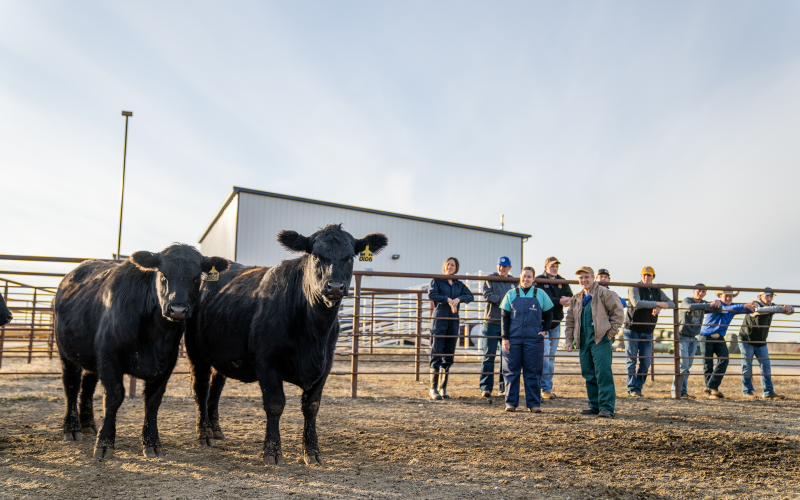Written collaboratively by Jessalyn Bachler, former SDSU Extension Range Field Specialist, and Krista Ehlert, Assistant Professor & SDSU Extension Range Specialist.
In the final article of the Poisonous Plants on Rangelands series, we will finish our discussion of common poisonous plants found on rangelands with a review of woody species. Several woody plant species that are poisonous to livestock are found throughout South Dakota rangelands, including ponderosa pine, chokecherry, greasewood and broom snakeweed. In dry years when forage is lacking, livestock will readily browse on woody plants.
Ponderosa Pine
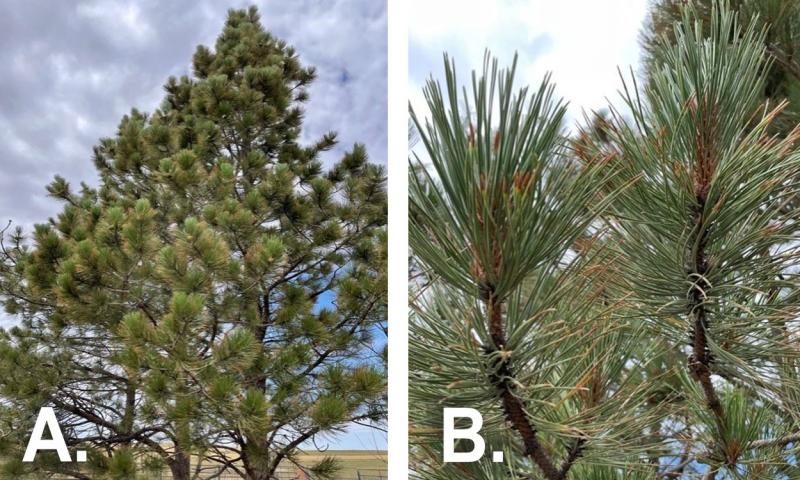
Ponderosa pine (Figure 1) is a large evergreen tree (up to 100+ feet tall) with greyish-brown bark on the branches and trunk, covered in flaking scales. Needles on the tree are found in clusters of two-to-three and are four-to-six inches in length with a sharp point; seed cones are scaley with sharp spines on the tip; they average two-to-five inches in length with seeds enclosed in a hard, thin hull. Ponderosa pine trees are found across South Dakota in wooded areas and are especially common across the Black Hills region.
Ponderosa pine needles contain isocupressic acid and can cause abortions when consumed by cattle, with cattle more susceptible to poisoning in the last trimester of pregnancy. The amount of ponderosa pine needle ingestion needed to cause abortion is highly variable between animals; cattle will abort within 48 hours to two weeks after consumption. Retained placenta is common after abortion due to ponderosa pine. Livestock will be encouraged to browse ponderosa pine needles if inadequate winter forage is available. To prevent livestock from consuming the needles, ensure supplemental forage is always available.
Chokecherry
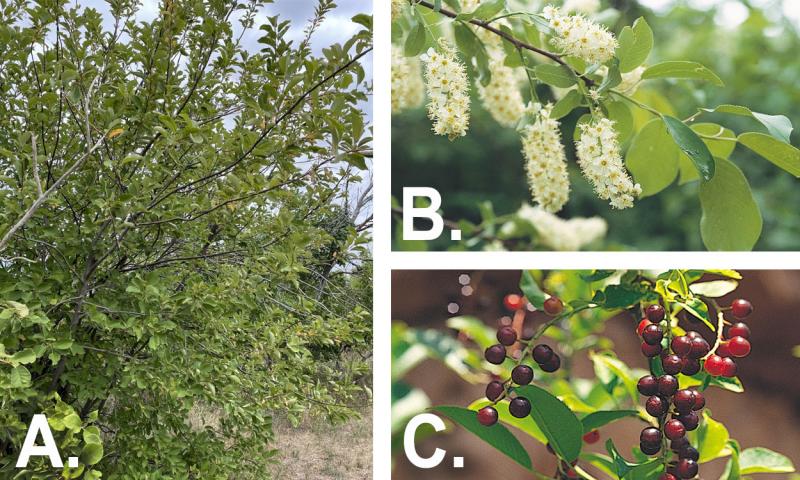
Chokecherry bushes (Figure 2) are small, deciduous, thicket-forming shrubs that range from five to 20+ feet tall with reddish-brown branches. The leaves on chokecherry bushes are thin, glossy and dark green in color and pointed at the end with serrated edges; the plant blossoms white racemes in May or June and bears small, cherry-like fruit that are purplish to black in color with a pit in the middle. Chokecherry bushes grow in a broad range of soils, along hillsides and riparian thickets, and they are especially common in the understory of forests.
Chokecherry bushes are frequently browsed by wildlife. However, due to the high level of hydrocyanic acid found in chokecherry leaves, the plant can be toxic to domestic livestock and cause cyanide poisoning. Young leaves on chokecherry bushes have the highest level of hydrocyanic acid; ingestion of 0.25 pounds can be a fatal dose for sheep. Poisoning generally occurs when a large amount of leaves are ingested in a short period of time, with a fast onset of symptoms and rapid death. Symptoms of chokecherry toxicity include distress and excitement, rapid breathing, muscle twitching, and convulsions, eventually leading to death from respiratory failure. Chokecherry poisoning is usually not treatable because of the rapid onset. Thus, best management practices are to prevent livestock exposure to chokecherry and ensure adequate forage is available.
Greasewood
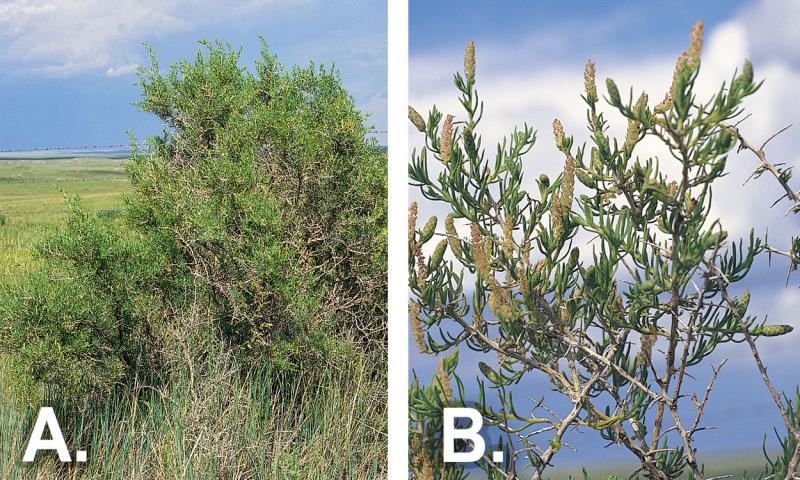
Greasewood (black greasewood) (Figure 3) is an irregularly shaped, shrubby plant that varies from two-to-five feet tall with smooth, white branches that are filled with thorns. The leaves on greasewood are narrowly linear, thick and fleshy and pale-green in color. The plant bears both male and female flowers, with male portions having several stamens enclosed in a cone-like spike and female portions showing a halo-like wing with fruits in the middle. Greasewood is a salt-loving plant that can be found in far western South Dakota, where saline or alkali soils are present, generally near boggy areas.
Because greasewood is a salt-loving plant, the leaves and young twigs can contain very high alkaline content (namely sodium or potassium oxalates) that can be poisonous to livestock in large quantities; sheep are especially susceptible. The content of toxic oxalates varies from plant to plant and is directly correlated with the amount of salts found in the soil in the specific area. If greasewood is the only forage available to livestock, bloating, poisoning and even death can occur. Symptoms of livestock poisoning from greasewood include weakness, rapid breathing, drooling, coma and eventual death.
Greasewood can be a valuable winter forage in semiarid regions if it is browsed modestly and supplemented with other good quality forages. Water should be salt-free and offered free choice. If livestock are encouraged to browse dense stands of greasewood, they should be introduced slowly and be full when going to browse the plant. Livestock can eventually be conditioned to browse greasewood and tolerate higher amounts of oxalates without being poisoned.
Broom Snakeweed
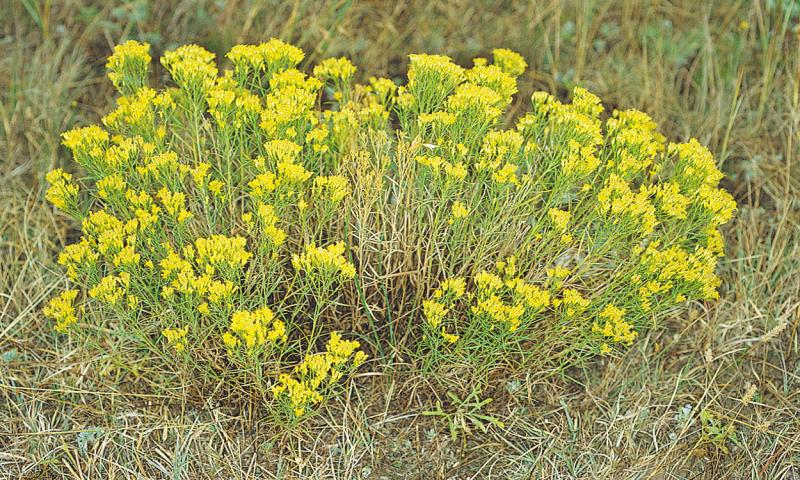
Broom snakeweed (Figure 4) is a small or half-shrub (up to three-feet tall) with three or more small yellow, ray-like flowers on the seed head that appear in August through September. Leaves on the plant are linear, with resinous glands dotted throughout and a thickened green tip. Broom snakeweed is commonly found in the western half of South Dakota on the short-grass prairie throughout the sagebrush communities.
A large presence of broom snakeweed can indicate overgrazing, drought, or another type of disturbance on rangelands. Broom snakeweed contains tremetol, an alcohol that is toxic to livestock. Varying amounts of broom snakeweed are said to cause poisoning; symptoms of poisoning include nasal discharge, diarrhea, weight loss, abortion and eventual death. Livestock generally avoid grazing broom snakeweed; however, if grazing occurs in a pasture that has a dense stand of it, ensure palatable forage is also available.
In Summary
If an outbreak of poisonous plants occurs in your pasture, it is best to avoid grazing that area until the plant can be controlled. Control options for poisonous plants include biological, mechanical or chemical control to prevent further spreading. Management strategies that producers should implement when grazing pastures that may contain poisonous plants include:
- Proper identification of poisonous plants common to your rangelands.
- Learning livestock species that are most-susceptible to poisoning.
- Ensuring adequate water and palatable forage are always available to livestock.
- Slowly and carefully introduce naive livestock to unusual toxic plants.
- Timing grazing to avoid poisonous plants when they are in their most toxic stage.
- Creating a grazing plan to prevent overgrazing and toxic plant introductions.
This article series only includes common poisonous plants on South Dakota rangelands, and it is not comphrehensive; numerous other poisonous plants can be found across the state. If you suspect a plant in your pasture may be toxic to livestock and are unable to identify it, reach out to your local range specialist: Jessalyn Bachler (Lemmon), Pete Bauman (Watertown), Krista Ehlert (Rapid City) and Sean Kelly (Winner). If you think that your livestock have been poisoned by a toxic plant, remove livestock from the pasture immediately and contact your veterinarian for further assistance.
